Want a list of birds that start with the letter D? Then look no further. In this article, we will look at the various birds that start with the D. The list includes some of the most beautiful and exotic birds from around the world. Everyone has their favorites but who is going to make sure we remember all these birds?
Dovekie (Alle Alle)
Popular in the Northern Hemisphere, the Dovekies are tiny birds colored in black and white, resembling flying billiard balls. They possess whirring wings and are efficient swimmers, mainly thriving on zooplanktons.
Dovekies are commonly seen in large groups across the Arctic and North Atlantic waters. They prefer to breed in large colonies on high rocky surfaces.
Due to their sturdy appearance, the Dovekies are also referred to as “Bull Bird” in Newfoundland.
Downy Woodpecker (Picoides pubescens)

The Downy Woodpeckers are popular as the tiniest woodpecker species in North America. These woodpeckers are partially migratory and can commonly be found across the deciduous forests within their range.
Their bill length and the black spots on their white tail feathers distinguish them from the Hairy Woodpeckers.
Although they mainly feed on insects, they’ve been found taking seeds and berries, too.
They nest on tree cavities in the summer months, while we can find them in the suburban backyards during winters.
Dusky Grouse (Dendragapus obscurus)

The Dusky Grouses are a forest-dwelling grouse species spread across mixed forests of the mountainous regions in the western parts of North America.
The adult males have dark-colored bodies, square-shaped tails, and a greyish shade alongside their purple throat. On the other hand, their female counterparts are brown-colored, having dark brown and white marks on their underparts.
Dusky Grouses feed on fir, douglas fir, hemlock in the winter, and green plants and insects during summer. Their newborns thrive on insects for the first ten days.
Dark-Billed Cuckoos (Coccyzus melacoryphus)
The Dark-billed Cuckoosare little birds found in Bolivia, Columbia, Argentina, Peru, Ecuador, Paraguay, Guana, Uruguay, Brazil, Venezuela, Peru, and French Guiana. The subtropics or tropical dry forests are the natural habitats of these birds.
Dark-billed Cuckoos are medium-sized birds distinguished from other cuckoos by their dark beak, a black mask around their eye, and anchored underparts.
The females have slightly larger plumage than their male counterparts. They’re colored in dull black or brown with white underparts, with a long, white-spotted tail.
Dusky Hummingbird (Phaeoptila sordida)
The Dusky Hummingbirds are a monotypic hummingbird species in the genus Phaeoptila. These birds are endemic to southwestern Mexico, commonly found in the subtropical or tropical moist lowland forests.
Both sexes of the Dusky Hummingbirds have a white stripe behind their eyes. However, the males possess a bright red bill struck with black, absent in their female counterparts.
Dusky Hummingbirds love to dwell in open areas, such as suburbs and trees. At times, you can even spot them in your yard or garden.
Dusky Pigeon (Patagioenas goodsoni)
The Dusky Pigeons are spread across Ecuador, Columbia, and Panama. These birds prefer to inhabit moist tropical lowlands and montane forests.
Dusky Pigeons have a mainly greyish-brown body, with a mellow reddish shade on their nape. Although they’re often compared to the Ruddy Pigeons due to their similar appearance, you can tell them apart by their voice.
The diet of these pigeons includes various grains, fruits, berries, seeds, and occasionally insects.
Double-striped Thick-Knee (Burhinus bistriatus)
Also referred to as “Shorebirds,” the Double-striped Thick-knees are large shorebirds found in Southern Mexico, South America, and Central America. These birds are a rare vagrant in the United States.
Their natural habitats are the open grasslands, savannahs, and agricultural lands. Sometimes they are spotted along the open woodlands too.
Double-striped Thick-knees primarily feed on worms, insects, and mollusks, with small vertebrates constituting their secondary diet.
Interestingly enough, when these birds sense any danger; they prefer to run rather than flying.
Double-Crested Cormorant (Nannopterum auritum)
Common across the fresh and salt waters of North America, the Double-crested Cormorants are waterbirds that have black-colored bodies and yellowish-orange facial skin. These birds are a center of attraction when spotted on the Rocky Islands.
Double-crested Cormorants are steadily built and are experts at diving to catch their prey, primarily small fish. Their characteristic double-crests are only seen in adults during the breeding season.
Double-toothed Kite (Harpagus bidentatus)
The Double-toothed Kites are birds of prey that belong to the Accipitridae family. These raptors are common across the Central American low-elevation forests.
Double-toothed Kites are small-sized birds with dark grey-colored bodies. The cutting border of their bill consists of a double notch that is difficult to spot. They also have a distinctive white rump, which is only visible in flight.
Double-toothed Kites are quick divers, a skill that comes in handy while catching their prey. They’re opportunistic hunters often roosting near monkey groups to capture prey apprehended by the large mammals. Insects and lizards make up 90% of their diet.
Dusky-Capped Flycatcher (Myiarchus tuberculifier)
Dusky-capped Flycatchers are passerine birds that belong to the tyrant flycatcher bird family. These birds are medium-sized and closely resemble the Myiarchus Flycatchers.
Dusky-capped Flycatchers are common across Middle and South America. Their preferred habitats are the forested and semi-open habitats like humid rainforests, oak-lined canyons, and
gardens.
These birds possess a blackish head with a short crest, a yellowish belly, and a slender bill. They prefer flycatching from the tree’s middle branches and also thrive on fruits.
Dusky Warbler (Phylloscopus fuscatus)
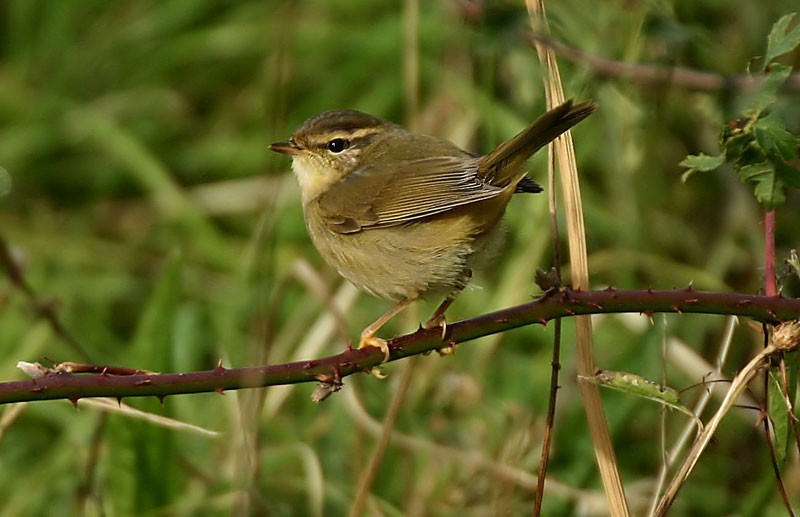
The Dusky Warblers are migratory birds occurring in North America; within the United States, you can find them in Alaska and California. During the winters, they travel to South Asia and Southeast Asia.
They inhabit dense low vegetation, open forests, and the border across the agricultural fields.
Dusky Warblers have muddy brown upperparts and pale underparts with a black eye line. These tiny songbirds consist of a conspicuous white supercilium with pointed bills. Their song sounds like a monotonous whistle.
Dark-sided Flycatcher (Muscicapa sibirica)

The dark-sided Flycatchers are tiny passerine birds breeding in the East Palearctic. These birds are partially migratory, with their northern population wintering in the south.
Dark-sided Flycatchers are also addressed by the names “Siberian Flycatcher” and “Sooty Flycatcher.” They primarily inhabit coniferous and mixed forests and are also found in woodlands, plantations, and parks.
Dark-sided Flycatchers mainly feed on insects. They have a brownish appearance, with dark streaks on their breast and paler wing bars and wingtips.
Dark-Eyed Junco (Junco hyemalis)
Common across the North American temperate region and the Arctic in the summer, the Dark-eyed Juncos are tiny, flashy sparrows. They mostly inhabit woodlands.
These birds are characterized by bright white tail feathers and are the most common forest birds of North America. They are easily recognizable by their crisp markings, which might be variable.
A recent report suggests the Dark-eyed Junco’s total population to be approximately 630 million.
Dwarf Cuckoo (Coccycua pumila)

Belonging to the Cuculidae bird family, the Dwarf Cuckoos are a tropical bird species commonly found in the Americas.
These birds inhabit tropical dry rainforests and moist lowland forests spread across Brazil, Columbia, and Panama.
They feature a grey head and uppers, a vibrant, rufous throat, red eyes, and a white belly. Very little is known about the sexual dimorphism between adults.
Interestingly enough, the Dwarf Cuckoos can breed all year round. Sometimes, two females are also spotted in the same nest, and both incubate the eggs.
Dusky Thrush (Turdus enormous)
The Dusky Thrushes are migratory birds, breeding in Siberia and wintering in southeastern Asia. They are an infrequent vagrant in North America and occasionally occur in western Europe.
These thrushes inhabit open woodlands, edges of Tundra, and shrubby riverine clumps.
Dusky Thrushes are medium-sized birds with rather stocky bodies. They’re mainly brown with reddish-brown underwings and white underparts covered in brown streaking.
They scavenge on the ground, walking and pausing momentarily, looking for prey like insects, worms,
and other little invertebrates.
Dickcissel (Spiza americana)
The Dickcissels are tiny seed-eating birds endemic to the Americas that belong to the Cardinalidae family.
They breed on the midwestern United States’ prairie grasslands, wintering in Northern Colombia, Central America, and Northern Venezuela. They form huge flocks during migration and in winters.
These birds have greyish-brown upperparts with black streaking, rusty shoulder patches, and dark wings. You can also spot a distinctive black V-shaped mark on their yellow chests.
Primarily feeding on insects and seeds, these birds forage on the ground. They nest near ground small shrubs or deep grasses.
The farmers across some regions recognize the Dickcissels as pests since their huge flocks can eat up their cultivated crops.
Dusky Nightjar (Antrostomus saturatus)
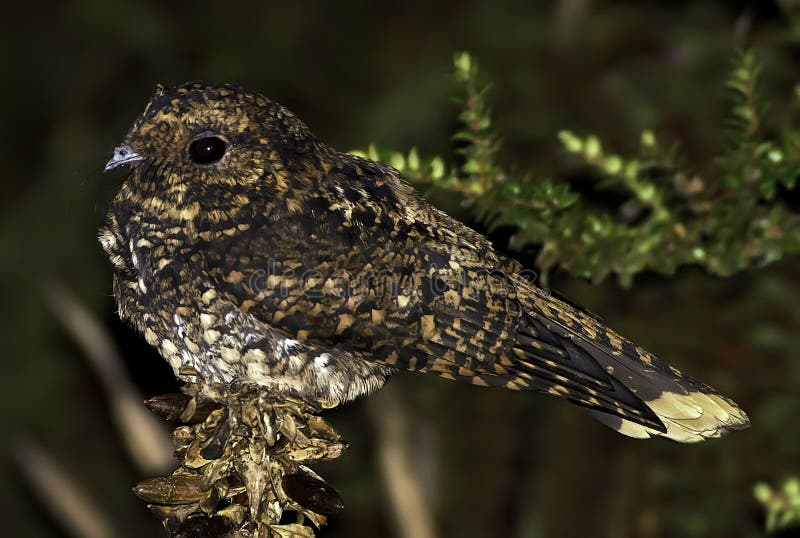
Belonging to the Caprimulgidae bird family, the Dusky Nightjars are a nightjar species found in western Panama and Costa Rica. They primarily inhabit the subtropical or tropical moist montane forests.
Characterized by triangular bills and long wings, the Dusky Nightjars consist of rounded tails. They have a camouflaged, dark brown body shaded with black.
The pale corners to their otherwise dark tail are white in the adult males and buffy in their female counterparts; these tail-tips are often used to tell the sexes apart.
The voices of these nocturnal birds are commonly used as a distinguishing factor between them and the other nightjar species.
Dickinson’s Kestrel (Falco dickinsoni)

Also referred to as “White-rumped Kestrel,” Dickinson’s Kestrels are a falcon species commonly found in southern and eastern Africa. They’ve been named after the English Physician, John Dickinson.
These birds have a small, stocky body coupled with a relatively large, square-shaped head. Their plumage is overall dark grey, with a paler head and rump. You can also notice black bars on their tail.
The adult Dickinson’s Kestrels have an identical plumage and display dimorphism in their size. Like most raptors, the females are larger and heavier than their male counterparts.
Other than feeding on insects and grasshoppers, these falcons also eat lizards and amphibians, at times even snakes or rodents.
Dusky Flycatcher (Empidonax oberholseri)
The Dusky Flycatchers are tiny insectivorous passerine birds belonging to the tyrant flycatcher family. Across North America, the mountain slopes and foothills are the breeding habitats of these birds.
The upper parts of the adult Dusky Flycatchers are olive-grey, whereas their underparts are whitish. They also have a dark bill and olive-grey breasts.
Flying insects like wasps, bees, and hornets are the primary food source of these birds.
Desert Owl (Strix hadorami)
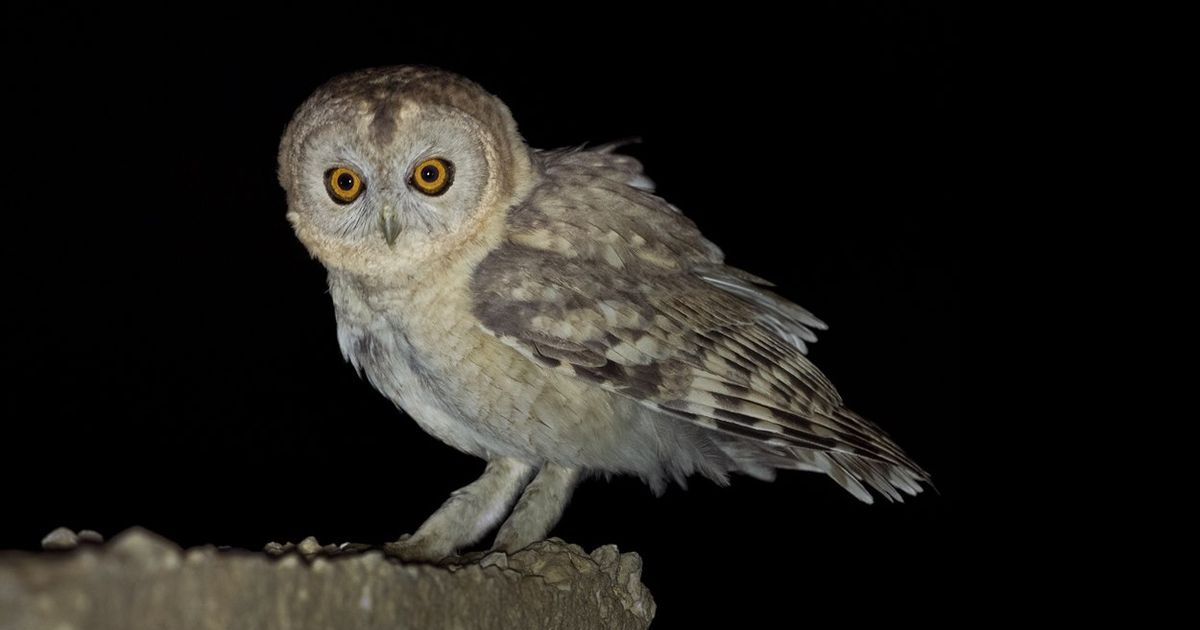
Previously named “Hume’s Owl,” the Desert Owls are an earless, true owl species that breed in Jordan, Israel, and the Arabian Peninsula. These owls inhabit deserts and semi-desert areas, including palm groves and rocky ravines, often nesting in cliff holes.
Owing to their smaller size, the Desert Owls’ diet consists of large insects, with an occasional vole or mouse.
In appearance, these owls are similar to the more popular Tawny Owls, only slightly smaller in size. They also have a much paler and lightly streaked body with vibrant yellow irises.
The voice of an adult Desert Owl is used to distinguish their sex; the females have a deeper voice than their male counterparts.
Dalmatian Pelican (Pelecanus crispus)
Ranked among one of the largest waterbirds in the world, the Dalmatian Pelicans also happen to be the largest members of the entire Pelican family. These gigantic birds have a wingspan that gives close competition to that of the Great Albatrosses.
The appearance of Dalmatian Pelicans is similar to that of the Great White Pelicans. The size of the males of both species often overlap, but as far as the females are concerned, the Dalmatian Pelicans far surpass the latter in size.
Dalmatian Pelicans have a silvery-white body with a long, heavy bill pointing downwards. The upper mandible of their bill is dark grey, while the lower is orangish. These birds also have remarkably curly feathers on their nape.
Both sexes of the adults harbor the same plumage, with the males being larger in size.
Darwin’s Flycatcher (Pyrocephalus nanus)

Closely related to the Vermilion Flycatchers, Darwin’s Flycatchers are native to Galapagos Islands. Due to the similarities in their appearance, these birds are also referred to as “Little Vermillion Flycatchers.”
These birds are listed under the Vulnerable Species List by the IUCN. They’re sexually dimorphic in their plumage, with the males possessing a bright red face and upper body, with darker back, wings, and tail.
On the other hand, the females are olive-grey with pale yellow undersides.
Dunnock (Prunella modularis)

Being the most widespread members of the accentor family, the Dunnocks are tiny passerine birds commonly found in the temperate areas of Europe and Asian Russia. These birds are also spotted in New Zealand, where they’re an introduced species.
Dunnocks are popular by several other names, such as “Hedge Sparrow,” “Hedge Warbler,” or “Hedge Accentor.”
They’re similar to a robin in size and have a brown body with paler underparts, except for their grey head. The adults are sexually monomorphic, with both sexes appearing identical.
Dwarf Bittern (Ixobrychus sturmii)
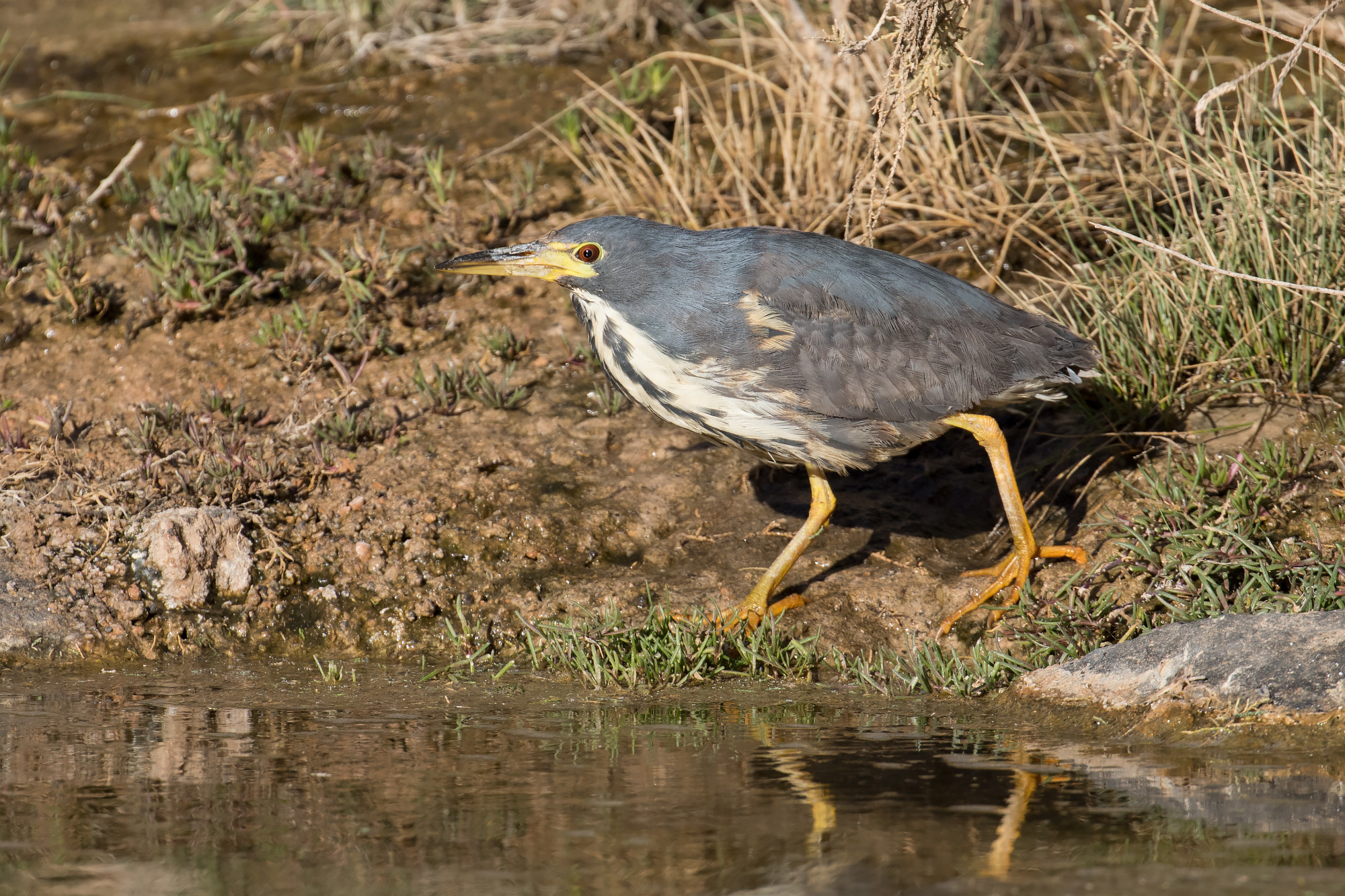
Just as their name suggests, the Dwarf Bitterns are among the smaller members of the heron family. These birds have a widespread distribution throughout North, Central, and South Africa and are spotted as rare vagrants in Europe.
Dwarf Bitterns are closely related to the Little Bitterns and are also similar to them in size and appearance. Their head and upper parts are covered in grey, with slightly lighter underparts.
Dunlin (Calidris alpina)
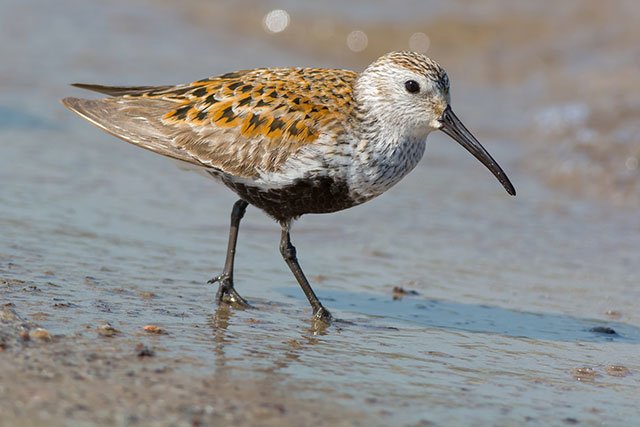
The Dunlins are tiny wading birds with prominently bowed bills. Their name comes from an older English dialect, in which the term “dun” refers to “dull brown,” like their body color.
These closely resemble the Curlew Sandpipers in their non-breeding plumage. However, the Dunlins are short-winged and short-legged, with darker body color.
During the breeding season, their underbelly, which is usually white, turns remarkably black, like their bill and legs.
Dusky Antbird (Cercomacroides tyrannina)
Also known as the “Tyrannine Antbird,” the Dusky Antbirds are tiny antbird species that inhabit tropical lowlands across forest edges and streams. These birds are the native breeders in the tropical regions of Central and South America.
These birds have a mainly greyish-brown body and are sexually dimorphic. The males feature a darker grey body with white wing bars. On the other hand, their female counterparts possess discolored faces and underparts; the wing bars are absent in them.
Dusky Eagle-owl (Bubo coromandus)

Commonly found in the South and Southeastern parts of Asia, the Dusky Eagle-owls are medium-sized raptor species that are popular for their dark, extended ear tufts.
These owls have a large, grayish-brown body with a light grey shade on their underparts. Their wings are covered in dark brown and contain significant white streaking. Little is known about the sexual dimorphism between adults.
Dwarf Jay (Cyanolyca nanus)

Popular as the tiniest member of the Corvidae bird family, the Dwarf Jays are a jay species that are endemic to Mexico. These corvids typically inhabit tropical moist montane forests.
They characterize an overall pale blue complexion with darker plumage, light blue eyebrows, and throat. These birds tend to forage in large colonies and can also be spotted foraging with the Stellar’s Jays.
Diamond Dove (Geopelia cuneata)
/GettyImages-90633796-6eeeb05ea7be4b4d86ce6458823dfc74.jpg)
Endemic to Australia, the Diamond Doves are a resident dove species that occur in semi-arid or arid areas with a water body nearby. These birds have been named after the diamond-shaped white speckles scattered all over their wings.
Diamond Doves have a light grey body with a creamy white shade on their belly. Their wings and tails are brownish-grey in color. Both sexes of the adults look similar, except for their eye rings; the males have more prominent eye rings than their female counterparts.
Conclusion: Birds That Start With D
You’ve come to the end of this list of birds that start with the letter D. I told you it is pretty impressive! Thanks for spending time with me as we’ve detailed a list of some of the best birds that begin with D.
If you can’t wait to read about even more types of winged creatures, we encourage you to continue exploring our website. After all, we do aim to provide you with an interesting variety of content. Does anyone know what’s next on our list? Stay tuned!
Birds By Alphabet (A-Z List)
Birds that Start with A
Birds that Start with B
Birds that Start with C
Birds that Start with D
Birds that Start with E
Birds that Start with F
Birds that Start with G
Birds that Start with H
Birds that Start with I
Birds that Start with J
Birds that Start with K
Birds that Start with L
Birds that Start with M
Birds that Start with N
Birds that Start with O
Birds that Start with P
Birds that Start with Q
Birds that Start with R
Birds that Start with S
Birds that Start with T
Birds that Start with U
Birds that Start with V
Birds that Start with W
Birds that Start with X
Birds that Start with Y
Birds that Start with Z














